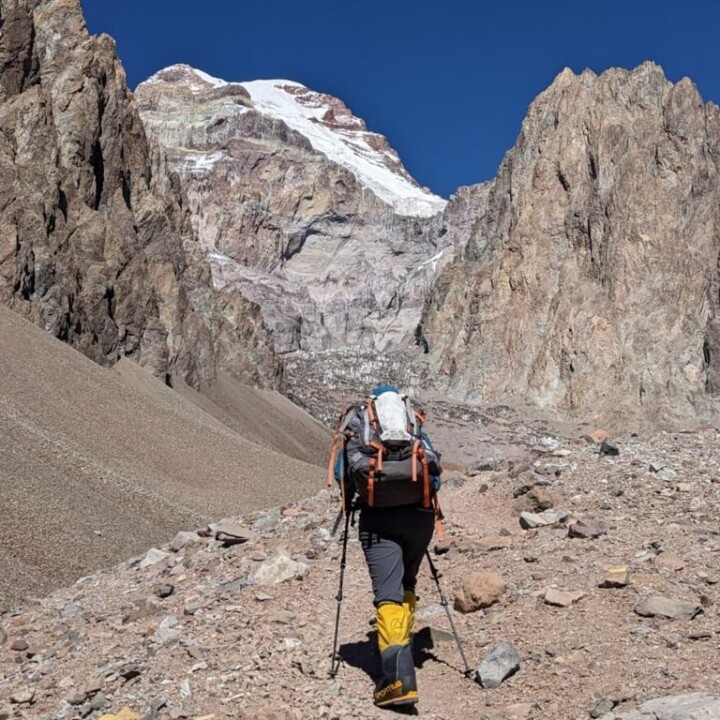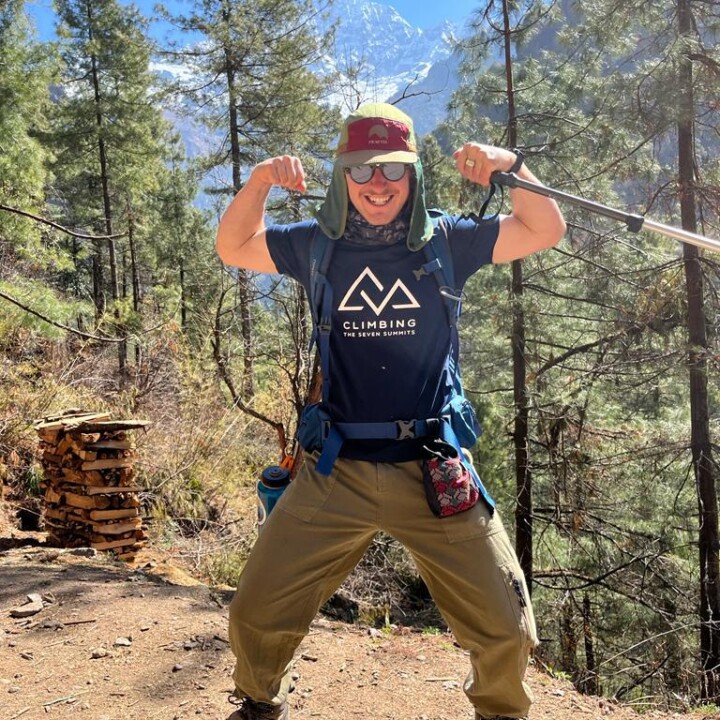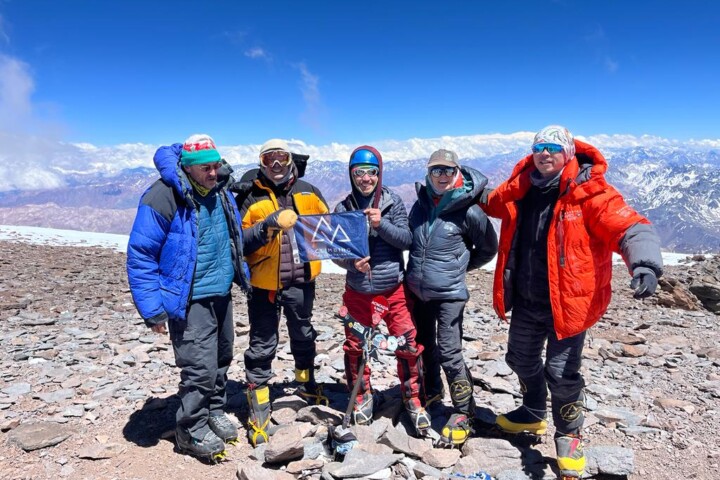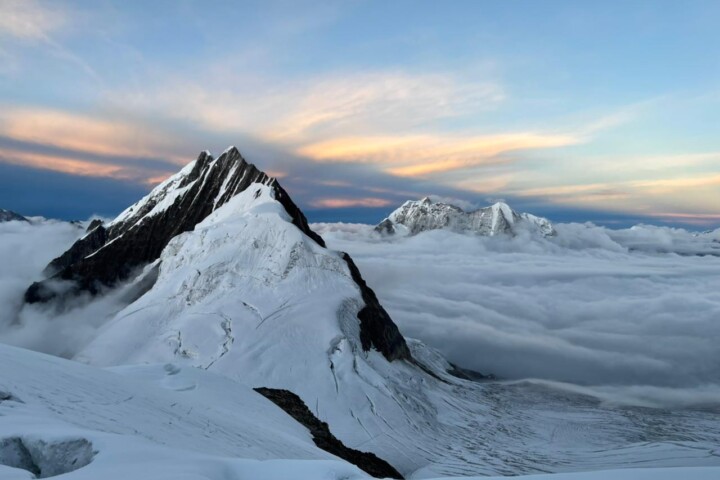Understanding Acclimatization & High-Altitude Environments: Part II

In Part I of our blog on acclimatization, we talked a lot about the physiological adaptations that allow our bodies to function effectively in low-oxygen environments. With proper acclimatization, you can mitigate the negative effects of those high-altitude environments on your physical performance and overall well-being. It’s actually quite incredible that our body can acclimate to these conditions over time, allowing us to climb in good style.
One of the most common questions we’re asked about acclimatization and high-altitude environments is how to predict what your body will do on your next climb. It’s imperative that anyone going into the mountains understands that individual responses to altitude vary, and not everyone acclimatizes at the same rate or to the same extent. Plus, your response each time will be different because of different environmental and physical factors, including how much water you’ve consumed, where you are in the world, and the overall weather conditions, all of which affect your ability to acclimatize on a particular expedition. Just because you acclimatized well on Kilimanjaro doesn’t mean your body will do the same on Aconcagua. Remember, some of the best climbers in the world need to allow more time for their bodies to adapt to altitude, and it’s okay if you’re in the same boat.
Pre-Acclimatization Strategies Before an Expedition
- Fitness Training: Your climb and acclimatization begins long before you step foot on the mountain. By incorporating proper training into your daily routine for at least six months before your departure date, you will help set yourself up for success as you acclimatize during your expedition. Remember, training doesn’t stop with just your fitness, and it’s crucial to be in top mental condition.
- Hypoxic Training: Hypoxic training involves exposing the body to reduced oxygen levels. This can be achieved through training in natural high-altitude environments to stimulate the physiological adaptations you will experience during your trip. Training in high-altitude environments will ultimately improve your performance and reduce susceptibility to altitude sickness during your expedition.
- Use of Hypoxico Tents and Chambers: If you are unable to travel to natural high-altitude environments, you can mimic the physiological adaptations experienced at altitude using Hypoxico Training Systems. These systems and devices allow mountaineers to acclimatize gradually at home in a controlled environment by reducing oxygen levels while sleeping or exercising.

Acclimatization Strategies During an Expedition

We employ a number of acclimatization strategies during our expeditions, which involve increasing altitude exposure in a deliberately unhurried manner, allowing the body time to adapt to the decreased oxygen levels, and taking rest days as a built-in feature of our itineraries. Here’s an overview of the acclimatization techniques we employ on all of our expeditions.
- Importance of Gradual Altitude Gain: A metered approach to altitude gain is critical for acclimatization because it allows the body to slowly adjust to decreasing oxygen levels. Climbing too quickly increases the risk of altitude sickness, as the body doesn’t have enough time to adapt.
- Slow Ascent Rates and Rest Days: Slow ascent rates and rest days are essential components of gradual ascent acclimatization. You’ve heard us say climb high, sleep low? These periods of venturing high and then sleeping lower allow our bodies to rest and make the critical adaptations for altitude. Rest days also provide an opportunity to monitor for symptoms of altitude sickness and adjust ascent plans accordingly.
- Hydration and Nutrition: On any expedition, hydration and nutrition play an integral role in how you feel in the mountains. On the flip side, due to long travel time, busy trip itineraries, and an all too often lack of appetite, it can also be hard to remember to adequately eat and drink. You must ensure that you don’t get behind on your food and fluid intake. To make things easier, we recommend training to eat and drink in the mountains along with your regular fitness training.
- Pharmacological Interventions: Medications can be used for altitude sickness prevention or treatment. Acetazolamide (Diamox) is a commonly prescribed medication that helps stimulate breathing and reduce the risk of altitude sickness. Other medications, such as dexamethasone or nifedipine, may be used for severe cases of altitude sickness. However, pharmacological interventions should be used judiciously, and climbers should be aware of potential side effects and interactions with other medications.
Hypoxico Altitude Training Systems
If you’re looking for a quicker timeline on the mountain, a hypoxic tent can shorten your expedition by facilitating acclimatization to high altitudes before your actual climb. Many climbers don’t have unlimited time off to pursue their mountain dreams and have busy lives with family and work, so utilizing a pre-acclimatization strategy that involves the use of a Hypoxico tent can help to shorten time away from work, family, and friends. Here’s how you can incorporate pre-acclimatization by using a hypoxic tent to expedite the acclimatization process.
- Pre-Trip Preparation: Before the mountaineering trip, set up the hypoxic tent in a comfortable and convenient location, over your bed or a guest bed if your pets or partner usually sleep with you and don’t want to also acclimatize. Ensure that the tent is properly installed and ventilated according to manufacturer instructions.
- Gradual Exposure: Begin using the hypoxic tent 6 – 8 weeks before your expedition. Start with a lower simulated altitude, typically equivalent to around 1,500 meters (5,000 feet) above sea level, and gradually increase the altitude over time. For every night that you sleep well, ascend 150 meters (500 feet). If you do not sleep well, remain at that altitude until you do, then ascend in altitude. Ascend until you have hit the altitude you are trying to acclimatize to.
- Consistent Use: Sleep in the hypoxic tent each night to expose your body to the reduced oxygen levels. Consistent nightly exposure helps stimulate physiological adaptations similar to those experienced at high altitudes, such as increased red blood cell production and improved oxygen utilization.
- Training Sessions: In addition to sleeping in the hypoxic tent, incorporate training sessions or workouts while breathing the reduced oxygen air. This can help enhance cardiovascular fitness and endurance, further preparing you for the physical demands of the mountaineering trip.
- Monitoring: Throughout the acclimatization process, monitor your response to the hypoxic exposure and adjust the altitude settings as needed. Pay attention to any symptoms of altitude sickness or discomfort and consult with a healthcare professional if necessary.
- Supplemental Training: While using the hypoxic tent, continue to engage in supplemental altitude training activities, such as hiking, climbing, or aerobic exercises, to further enhance acclimatization and physical conditioning.
By using a Hypoxico tent to simulate altitude exposure before the mountaineering trip, you can expedite the acclimatization process and reduce the time on an expedition by 30-50%. As always, if you are using a Hypoxico system, it’s essential to supplement your Hypoxico tent usage with other aspects of mountaineering preparation, including physical training, proper gear selection, and knowledge of altitude-related risks and safety protocols.
It’s important to note that Hypoxico systems should only be used in support of a Speed Ascent-style expedition and in collaboration with your mountaineering guide service. Traditional expeditions, which make up the majority of CTSS trips, include ample time for acclimatization, and using these systems may result in unnecessary pre-trip illnesses and a reduced ability to recover from your training.
CTSS Speed Ascents
Our Speed Ascent programs provide considerably shorter itineraries by taking advantage of pre-acclimatization technology in the comfort of your own home before you depart. It’s important to remember that you can’t cut corners to acclimatize, but you can save time on the mountain if you take advantage of the training systems that Hypoxico offers. Below are a few Speed Ascents that we offer.
Aconcagua
Having pre-acclimatized at home, you can fly directly into Plaza Argentina Base Camp by helicopter where you will meet your guides and teammates, skipping the long trek in.

Price: Starts from $9,995 USD
Dates: December 27, 2024 – January 10, 2025 and February 6 – 20, 2025
Trip Length: 15 days (standard itinerary is 20 days)
Mount Everest
Our Speed Ascent program is designed around a 40-day schedule, but we can offer a more aggressive 30-day schedule. Please note that the shorter schedule requires more pre-acclimatization at home.

Price: Add $10,000 – $12,000 USD to your selected Everest program
Dates: Annually on April 12 (40-day) and April 20 (30-day)
Trip Length: 30 or 40 days (standard itinerary is 58 days)
Lhotse
We offer two different Speed Ascents, one with a personal Sherpa and the other with a private Western guide. A Speed Ascent will join the team in Pheriche just before heading to base camp.

Price: $44,995 USD (personal Sherpa) – $84,995 USD (Western guide)
Dates: Annually between April and May; contact us for custom date planning.
Trip Length: 30-40 days (standard itinerary is 52 days)
Manaslu
Our Speed Ascent program is designed around a 32-day schedule. If you are pressed for time, we offer a more aggressive 22-day schedule. Please note that the shorter schedule requires more pre-acclimatization at home.

Price: $32,995 – $34,995 USD
Dates: Contact us for custom date planning
Trip Length: 22 or 32 days (standard itinerary is 42 days)
Are you looking for some strategies to help you acclimatize properly?
Head to our Understanding Acclimatization and High-Altitude Environments: Part I blog to learn more about the physiology of acclimatization and how to identify and mitigate altitude illnesses. You can also check out our Mountaineering 101: Understanding Acclimatization and High-Altitude webinar!